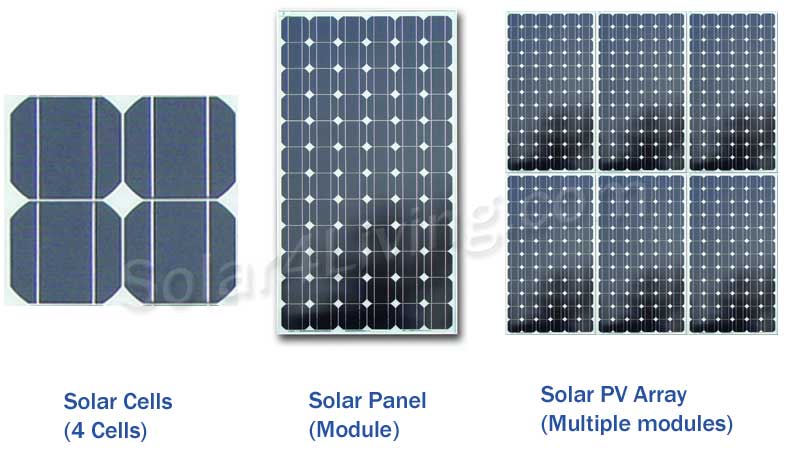Solar Panel Basics
Solar Cell, Panel, Module or Array?
You may have heard of these terms. But what do they mean?

A solar cell is the most basic element of a photovoltaic (PV) system. A single cell by itself only produces a small amount of power. With current technologies, it is only practical to make cells no bigger than an average kitchen tile. Larger cells are possible, but would be prohibitively expensive and much more difficult to integrate into a panel or array. Most solar cells will only produce half a volt. The larger the cell is, the more current it will produce. A teacup saucer sized cell produces roughly 4 to 5 amps in ideal conditions.
A solar panel, or module, is a self-contained unit made up of a number of solar cells. The panel is held together by a sturdy aluminium frame, and thick tempered glass protects the cells, whilst still allowing sunlight to stike the cells. The cells are usually connected in series to attain a higher voltage. By connecting the 0.5 volt cells in series, a higher, more useful voltage is obtained. A clear layer of UV-resistant acrylic holds all the cells in place behind the glass.
A solar array is the largest unit in a PV system. An array contains two or more solar panels (or modules). The panels can be connected in series, parallel, or a combination of both to produce a much higher voltage and/or current than a single panel can produce alone.
Solar Panel Performance
There are several factors which affect the performance of solar panels.
The most important factor is the amount of insolation, i.e. the amount of time the sunlight is hitting the panels, and the angle at which the sunlight is shining at. In winter, the angle of the sun is low. Coupled with less daylight hours, this equates to less output (or electricity generation) from the panel. Your location also affects insolation. Higher latitudes will result in lesser insolation and much higher variance between summer and winter.
Another factor is temperature. The output of a panel is tested in laboratory conditions, at a certain temperature - the results of these tests are indicated on the panel's nameplate, that specifies the number of volts and amps the panel will produce in ideal conditions (Wp, or Watts Peak). In the real world, temperatures vary, depending on the climate and season. When the panel is hotter than the lab test conditions, the electrical output will start to drop. On very hot days, a solar panel will not be operating at its peak. Solar cells produce electricity from light and not heat. Like many other electronic devices, solar cells will operate best when kept cool. The reason solar panels generate less electricity in winter is not due to the cooler temperatures, but due to less insolation (from low sun angles and greater cloud cover).
A less critical factor is solar panel age. Like most other electronics, the silicon in the solar cells will degrade over time - more so with solar PV, primarily because the electrical materials are deliberately exposed to sunlight (whereas other electronic devices are covered or shielded from the external environment). The degredation is quite slow however - in the order of approx. 1% per year. Therefore, after 10 years, a quality solar panel will still be guaranteed to produce 90% of its factory rated output.
Solar Panel durability
Modern solar panels are maintenance free. Accumulated dust is generally cleared by rainfall. Monocrystalline and polycrystalline modules are completely sealed, and unless the glass is cracked, they are impervious to water. Many panels are still operating after 25 years. Unless more power is required, there should be no reason why the same panel couldn't be used for another 25 years.
See also: Hail & solar panels
